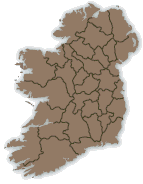Croc an bhodaigh - Eoin Ó Cianáin
Recording: [Download audio file]
[Download AIFF audio file (of processed ‘user’ version)]
[Download AIFF audio file (of archive version)]
Transcript
Bhí fear thíos anseo ar Thoigh Bán Luí na Gréine a bheir siad Paidí Ó Lochráin air. Agus bhí sé ag treabhadh aon lá amháin áiridhe, é féin agus a chomrádaí. Bhí seisean ag coinneált an mhaide[1] agus bhí an comrádaí ag tiomáint na gcaiple. Nuair a tháinig scairt orthu chun a ndinnéara, d'amharc[2] sé síos 'uig a chois agus bhí sé i ndéidh crocán óir a nochtadh.
"Anois, rachaidh muid 'na mbaile[3]," arsa seisean leis an fhear, "ag ár ndinnéar, ár ndinnéar." "Chan (ársaim aon) dadaí bhua[4] seo dó," a deir sé, "for[5] a chaithfinn (páirt den airgead) a thabhairt dó."
Fuaidh siad 'na mbaile 'uig a ndinnéar agus tháinig sé ar ais chun an crocán óir a thógáilt é féin 'air[6] a bhí an dinnéar thart. Agus 'air a tháinig sé ar ais chun an chnoic bhí an cnoc uilig falaiste[7] le maidí seisrí. Agus chuaigh sé ón chionn amháin go dtí an cionn eile ag cuartú a chionn féin. Má tá, cha dtiocfadh leis a dhéanamh amach for a bhí siad uilig cosúil lena chionn féin.
Nuair[8] a bhí sé corthaí ag cuartú, d'fhág na maidí seisrí uilig an cnoc ach a chionn féin, agus 'air a d'amharc sé bhí a chionn féin aige. Má tá, cha rabh aon dadaí den chrocán óir, bhí sé ar shiúl comh maith le na[9] maidí seisrí. Thiontaigh sé 'na mbaile agus bhí an t-airgead caillte aige. (Ní thiocfadh leis) aon leithphínn de a thabhairt don fhear bhocht a bhí ag tiomáint na gcaiple.
Translation
There was a man down here at Teebane West who was called Paddy Loughran. And he was ploughing this one day, himself and a friend. He was holding the (ploughing) stick and his friend was directing the horses. When they were called to dinner, he looked down at his foot and he had just unearthed a crock of gold.
"Now, we'll go home," he said to the other man, "to our dinner, our dinner." "I won't say anything to him about this," he said, "for I'd have to give him some of the money."
They went home to their dinner and he came back to take the crock of gold himself when the dinner was over. And when he returned to the hill the whole hill was covered with ploughs. And he went from one to the other looking for his own. However, he couldn't distinguish it for they were all identical to his own one.
When he was fed up searching, all the ploughs disappeared from the hill but his own, and when he looked he had it. However, there was no sign of the crock of gold, it had disappeared along with the ploughs. He turned for home and he had lost the money. He couldn't even (?) give a halfpenny to the poor man who was driving the horses.
Footnotes
For the pronunciation of -ai- cf. Éamonn Ó Tuathail, Sgéalta Mhuintir Luinigh (Dublin, 1933), xvi. (Back)Leg. d'amhac? Cf. Heinrich Wagner, Gaeilge Theilinn (Dublin, 1959, repr. 1979), § 410. (Back)
= chun an bhaile. Cf. Ó Tuathail, op. cit., xxxiii: ag goil ’na mbaile 'going home'; ag goil ’na bhaile 'going to town'. (Back)
= fá. Cf. Gerard Stockman and Heinrich Wagner, 'Contributions to a study of Tyrone Irish,' Lochlann 3 (1965), 43-235: 156, 209. (Back)
= English for. Cf. Stockman and Wagner, op. cit., 163. (Back)
= nuair. Cf. Emrys Evans, 'The Irish Dialect of Urris, Inishowen, Co. Donegal', Lochlann 4 (1969), 1-130: 80. (Back)
= falaithe/folaithe. Cf. Dónall Ó Baoill, An teanga bheo: Gaeilge Uladh (Dublin, 1996), 19. (Back)
Leg. ’air? (Back)
= leis na. Cf. Stockman and Wagner, op. cit., 209. (Back)
Commentary
This is a version of a legend that is well known in Ireland, which usually, though not in this case, involves a leprechaun as well as a cache of buried treasure. For further examples and a list of print versions, see Diarmuid Ó Giolláin, 'The leipreachán and fairies, dwarfs and the household familiar: a comparative study', Béaloideas 52 (1984), 75-150: 85. The central theme of the story sees the site of the treasure marked, but when the finder returns, there are many other markers placed in the area, making retrieval impossible. It is ultimately based on an international motif, K415 Marked culprit marks everyone else and escapes detection. See Stith Thompson, Motif-index of folk literature (rev. and enlarged ed., 6 vols, Bloomington, Ind., 1955-8).
This story is transcribed in Heinrich Wagner and Colm Ó Baoill, Linguistic atlas and survey of Irish dialects (4 vols, Dublin, 1958-69), vol. 4, 288, and in Róise Ní Bhaoill, Ulster Gaelic voices: bailiúchán Doegen 1931 (Belfast, 2010), 204-6.
Title in English: The churl's crock of gold
Digital version published by: Doegen Records Web Project, Royal Irish Academy
Description of the Recording:
Speaker:
Eoin
Ó Cianáin from Co.
Tyrone
Person who made the recording:
Karl Tempel
Organizer and administrator of the recording scheme: The Royal Irish Academy
In collaboration with: Lautabteilung, Preußische Staatsbibliothek (now Lautarchiv,
Humboldt-Universität zu Berlin)
Recorded on 24-09-1931 at 11:00:00 in Queen's
University, Belfast. Recorded on 24-09-1931 at 11:00:00 in Queen's
University, Belfast.
Archive recording (ID LA_1209d1, from a shellac disk stored at the
Royal Irish Academy) is 01:21 minutes
long. Archive recording (ID LA_1209d1, from a shellac disk stored at the
Royal Irish Academy) is 01:21 minutes
long.
Second archive recording (ID LA_1209b1, from a shellac disc stored in
Belfast) is 01:22 minutes long. Second archive recording (ID LA_1209b1, from a shellac disc stored in
Belfast) is 01:22 minutes long.
User recording (ID LA_1209d1, from a shellac disk stored at the Royal
Irish Academy) is 01:20 minutes long. User recording (ID LA_1209d1, from a shellac disk stored at the Royal
Irish Academy) is 01:20 minutes long.





